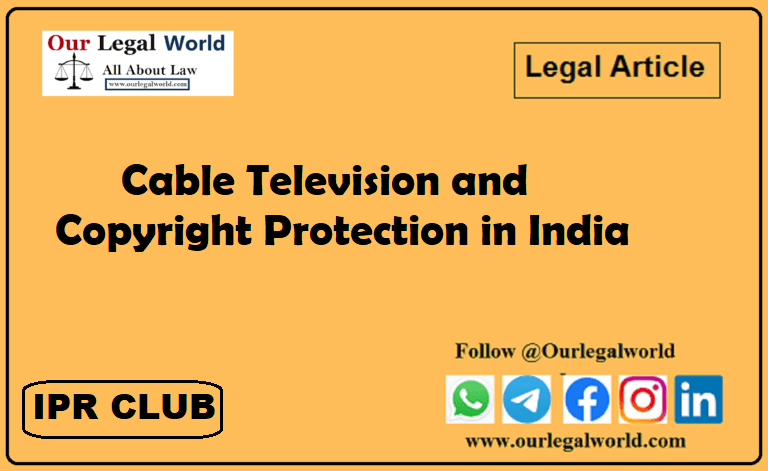Cable Television and Copyright Protection in India:- IPR Club
Written by Ekanandanayaka S [NUALS]
Introduction:
Cable television is a type of television transmission system that distributes television signals to subscribers via coaxial or fibre-optic cables. Cable television has been a popular form of television delivery in India since the early 1990s. The cable television industry in India is regulated by the Cable Television Networks (Regulation) Act, 1995 (CTN Act), which was enacted to regulate the operation of cable television networks and prevent the transmission of unauthorized channels.
The issue of copyright protection in India is a complex and contentious one. India has a long history of piracy and copyright infringement, which has resulted in significant losses for copyright owners in the country. The Indian government has made a number of measures to solve this problem, including the enactment of the Copyright Act, 1957 and its subsequent amendments.t
Legal Framework for Cable Television in India:
The Cable Television Networks (Regulation) Act, 1995 (CTN Act) is the primary legislation governing the cable television industry in India. The CTN Act provides for the regulation of the operation of cable television networks and prevents the transmission of unauthorized channels. Under the CTN Act, cable television operators are required to obtain a license from the government to operate a cable television network. The license is granted by the Ministry of Information and Broadcasting, and the license fee is determined by the government.
Also Read: Protection of Geographical Indication Towards Tourism Approach
The CTN Act also provides for the regulation of the content that can be transmitted on cable television networks. The Act prohibits the transmission of any program that is not in conformity with the laws of India or that is likely to offend against good taste or decency. The Act also prohibits the transmission of any program that is likely to encourage or incite violence or that is likely to disturb public tranquillity.
In addition to the CTN Act, the Cable Television Networks Rules, 1994 also regulate the operation of cable television networks in India. These rules provide for the technical standards that cable television networks must meet, the procedures for obtaining a license, and the procedures for renewing a license. The rules also provide for the regulation of advertising on cable television networks.
Legal Framework for Copyright Protection in India:
The Copyright Act, 1957 is the primary legislation governing copyright in India. The Copyright Act provides for the protection of Along with cinematic films, there are literary, theatrical, musical, and aesthetic works and sound recordings. The Copyright Act also provides for the protection of performers’ rights and the rights of broadcasting organizations.
The Copyright Act provides for the registration of copyright, although registration is not mandatory for the protection of copyright in India. The Act also provides for the assignment and licensing of copyright, as well as the protection of moral rights.
In addition to the Copyright Act, the Indian government has also enacted the Information Technology Act, 2000, which provides for the protection of digital works and the regulation of digital signatures and electronic records. The Indian Penal Code also provides for criminal sanctions for copyright infringement, including imprisonment and fines.
- Copyright owners in the cable television industry face several challenges, including:
- Piracy: Piracy is a significant challenge for copyright owners in the cable television industry. With the rise of online streaming and torrenting websites, it has become easier for people to access copyrighted content without paying for it. This not only results in lost revenue for copyright owners, but it also devalues their content.
- Competition from alternative platforms: With the rise of alternative platforms like Netflix and Amazon Prime Video, cable TV is facing competition like never before. These platforms offer a wide range of content that can be accessed at any time, which makes them a more appealing choice for many viewers. This competition has put pressure on cable TV providers to offer more diverse and high-quality content.
- Changing consumer behaviour: Consumers are increasingly consuming content on-demand and through streaming services. This implies that they are less inclined to watch live TV, which is traditionally how cable TV providers deliver content. As a result, cable TV providers must adapt to this changing consumer behaviour by offering more on-demand and streaming options.
- Legal and regulatory challenges: Copyright owners in the cable television industry must navigate a complex web of legal and regulatory requirements. For example, they must ensure that they have the proper licenses and agreements in place with cable TV providers and that they are complying with various copyright laws and regulations.
- Technological advancements: The cable TV industry is constantly evolving, and new technologies like virtual reality, augmented reality, and 5G are set to have a significant impact on the industry. Copyright owners in the cable TV industry must be prepared to adapt to these technological advancements and embrace new opportunities to reach their audiences.
- There have been several cases in India relating to cable television and copyright protection. Some of the notable ones are:
- Star India Private Ltd. v. Leo Burnett (India) Private Ltd. & Ors. (2003): The question of whether cable operators that broadcast television channels without permission were liable for copyright infringement was the subject of this case.The Court held that cable operators who re-transmit television signals without authorization from the copyright owner were liable for infringement.
- ESPN Software India Pvt. Ltd. & Ors. v. Tudu Enterprise & Ors. (2012): In this case, the Court held that cable operators who distribute signals of sports channels without authorization are infringing on the copyrights of the broadcasters.
- Multi-Screen Media Pvt. Ltd. & Anr. v. Sunita Sharma & Anr. (2014): The Court held that cable operators who use pirated set-top boxes to distribute television channels are liable for copyright infringement.
- In Re: TV Today Network Limited and Ors. v. M/S The New Delhi Television Limited and Ors. (2016): This case dealt with the issue of whether the practice of ‘content scraping’ by television channels was a violation of copyright. The Court held that the unauthorized use of content by television channels amounted to copyright infringement.
These cases highlight the importance of copyright protection in the cable television industry and the need for cable operators to obtain proper authorization before broadcasting television channels. They also demonstrate the courts’ willingness to enforce copyright laws to protect the rights of broadcasters and other copyright owners.
CASE LAWS
- Star India Private Limited v. J.D. Cable Network & Ors. (2009) – In this case, the plaintiff, Star India Private Limited, sued the defendants, cable operators, for copyright infringement for broadcasting its copyrighted content without authorization. The Delhi High Court made a decision in the plaintiff’s favour and granted an injunction restraining the defendants from broadcasting the plaintiff’s content without authorization.
- Music Broadcast Private Limited v. Super Cassette Industries Limited (2011) – In this case, the plaintiff, Music Broadcast Private Limited, sued the defendant, Super Cassette Industries Limited, for copyright infringement for broadcasting its copyrighted music without authorization The Delhi High Court made a decision in the plaintiff’s favour and granted an injunction restraining the defendant from broadcasting the plaintiff’s music without authorization.
- ESPN Software India Private Limited v. TAJ Television Limited (2012) – In this case, the plaintiff, ESPN Software India Private Limited, sued the defendant, TAJ Television Limited, for copyright infringement for broadcasting its copyrighted content without authorization. The Delhi High Court made a decision in the plaintiff’s favour and granted an injunction restraining the defendant from broadcasting the plaintiff’s content without authorization.
- UTV Software Communications Limited v. 1337X.To (2019) – In this case, the plaintiff, UTV Software Communications Limited, sued the defendant, 1337X.To, for copyright infringement for allowing users to download and stream its copyrighted content without authorization. The Delhi High Court made a decision in the plaintiff’s favour and ordered the defendant to remove all infringing content from its website.
Conclusion:
In conclusion, cable television is a significant part of the media landscape in India. However, copyright protection is a significant concern in the industry, with many cable TV operators engaging in copyright infringement. The government has taken several measures to address this issue, including the introduction of the DAS system. While these measures have helped to reduce the incidence of copyright infringement, there is still a long way to go in terms of protecting the rights of content creators and broadcasters. It is crucial that the government keeps taking action to improve copyright protection in India’s cable TV sector.
Cable television and copyright protection are two important topics that have long been up for discussion in India. Cable television has been a popular mode of entertainment in India, especially in rural areas where there is limited access to other forms of media. However, the lack of effective copyright protection has led to rampant piracy and unauthorized broadcasting of copyrighted content on cable networks.
The Indian government has made a number of measures to solve this issue, including the introduction of the Cable Television Networks (Regulation) Act, which requires cable operators to obtain licenses and follow certain regulations regarding the content they broadcast. Additionally, the government has implemented digitalization of cable networks to prevent piracy and unauthorized broadcasting of content.
However, there are still challenges in enforcing copyright protection on cable television in India, and to properly address this issue, better legal frameworks and enforcement measures are required.
In conclusion, while cable television has been an important mode of entertainment in India, copyright protection is essential to ensure the rights of content creators are protected. The Indian government has taken several steps to address this issue, but there is still a need for further efforts to strengthen the legal framework and enforcement mechanisms to effectively protect copyright in the cable television industry.
BOOKS, ACTS AND REFERANCES
- Cable Television and Copyright Owners | Corporate Law Reporter
- Cable Television Networks (Regulation) Act, 1995 A1995-07.pdf (indiacode.nic.in)
- https://www.indiacode.nic.in/bitstream/123456789/1928/1/A1995-07.pdf,
- The Indian Copyright Act, 1957
- Copyright Law in India by A book by Feroz Ali.
- TRAI (Telecom Regulatory Authority of India)
- Association of Cable Operators of India (ACOI)
- The Cable Television Networks (Amendment) Rules, 2021
- Cable Television Networks (Regulation) Act, 1995 — The Centre for Internet and Society.
- Satellite Retransmission and the Passive Carrier Copyright Protection in the Cable Television Industry (fordham.edu)
- CABLE TELEVISION AND INTERNATIONAL GOVERNANCE: AN OVERVIEW (ijirl.com)
- Cable Television and the Compulsory Copyright License (indiana.edu)
- Copyright Infringement In Playing Television Channel – Copyright – India (mondaq.com)




![Call for Campus Ambassadors by Our Legal World [2 Months; Virtual]: Apply by June 15](https://www.ourlegalworld.com/wp-content/uploads/2024/06/Logo-New-136x150.png)


